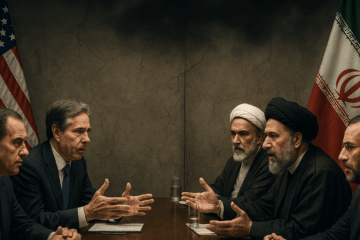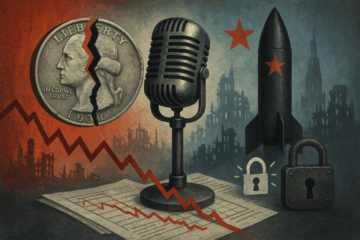In a reply to a recent article in Global Security Review, which advocated for American escalation dominance, Katerina Canyon, Executive Director of the Peace Economy Project, challenged the importance of escalation dominance, instead advocating for a reduction in nuclear weapons and an increase in domestic spending. Canyon is wrong on three points: the history of the Cuban Missile Crisis, who started the nuclear arms race, and the need for nuclear cost cutting.
The Cuban Missile Crisis
Canyon begins her article by employing the Cuban Missile Crisis as an example of where diplomacy rather than military force carried the day. Her explanation is simple disinformation and misunderstands how nuclear deterrence works.
Early in the crisis, President John F. Kennedy moved nuclear-armed bombers to Air Force bases in Florida, lining them up wing tip to wing tip, as a visible display of the nuclear hell both Cuba and the Soviet Union would face if Nikita Khruschev did not remove nuclear weapons from Cuba. That signal was seen by the Soviets.
President Kennedy also called the then-recent deployment of Minuteman I intercontinental ballistic missiles (ICBM) his “ace in the hole.” He credited his ICBMs with forcing the Soviets to back down. Minuteman I was very much American escalation dominance that the Soviets could not match.
He also implemented a blockade around Cuba. When the Soviet submarine B-59 attempted to run the blockade, the USS Beale depth charged the submarine. Rather than launching its nuclear torpedoes against the Beale, B-59 retreated.
Contrary to Canyon’s assertion that diplomacy carried the day, it was military strength and nuclear superiority that carried the day. General Secretary Khruschev knew that the United States had a superior nuclear arsenal and backed down.
Arms Racing
Canyon is also concerned that the United States will invite an arms race should it develop the full spectrum of capabilities that are required to effectively deter China, North Korea, and Russia. The reality is the race has already begun. The only participant that is yet to leave the starting block is the United States.
Russian strategic nuclear modernization is nearly complete, with Russia also maintaining at least a 10 to 1 advantage in theater nuclear weapons. China is adding at least 100 new nuclear weapons per year and will soon outmatch the United States.
North Korea is now capable of striking the homeland with intercontinental ballistic missiles. According to Kim Jung Un, North Korea will build an arsenal of 500 nuclear weapons.
It is only the United States that is yet to field a new nuclear delivery system. The newest American nuclear delivery vehicle, the B2 bomber, is three decades old.
Contrary to the aspirations of nuclear disarmament advocates in the United States, not a single nuclear-armed adversary is willing to follow the United States down the path of disarmament. The post–Cold War era, three decades now, is a glaring example of the failures of the disarmament delusion.
Canyon is completely wrong when she asserts that China and Russia are modernizing and expanding their nuclear arsenals because of American nuclear modernization. They began their own nuclear modernization and expansion efforts long before the United States began its effort to replace aging weapons with new variants.
It was not American nuclear weapons that drove Chinese and Russian modernization to begin with. It is American superiority in conventional precision-guided weapons, which neither adversary can match, that led them to follow a strategy like President Dwight Eisenhower’s New Look Policy.
For some reason, Canyon claims that the ability to maintain nuclear escalation dominance is advocating “unchecked militarization.” Nothing could be further from the truth. Nuclear forces are a deterrent to conventional military aggression. Historically, great powers wage war four to six times per century, killing millions in the process. Nuclear weapons put an end to great power war and led to a more than 90 percent decline in conflict-related casualties. Lest Canyon forget, the last great power war, World War II, led to the death of 70 million people and saw the United States spend almost half of its gross domestic product fighting the war.
Canyon, like many in the disarmament community, mistakenly believes that weakness leads to peace. They incorrectly impose their own aversion to conflict onto Xi Jinping, Vladimir Putin, and Kim Jung Un. In reality, these authoritarians, who are actively seeking to topple the American-led international order, only see American passivity as weakness and an opportunity to coerce the United States.
Peace through strength is no mere slogan. It is the most accurate and effective way to deter America’s adversaries and ensure they never believe that they can achieve their objectives through conflict.
Defense Spending
Canyon also argues that defense spending is too high and the need to modernize all three legs of the nuclear triad is wasteful. Instead, she proposes increasing spending on social programs. Any examination of federal, state, and local budgets illustrates that Canyon is again incorrect.
In 2024, the federal budget was $6.75 trillion. Of this, $841.4 billion, 14 percent, went to defense spending. Of defense spending, about $50 billion was dedicated to current operation and modernization. This was about 6 percent of defense spending and less than 0.1 percent of federal spending.
Federal, state, and local governments spent more than $10 trillion in 2024. The federal government alone spent 69 percent of its budget on social programs. That is approximately $4.6 trillion—more than all federal revenue collected ($4.4 trillion) in 2024. Excluding federal pass-through funds, state and local governments spent an additional $4 trillion in 2024. State and local governments spent 65 percent of their budgets on social programs—another $2.6 trillion. Federal, state, and local governments spent $1.8 trillion just on anti-poverty programs—more than twice the defense budget.
According to the Centers for Medicare and Medicaid Services, the federal agency that runs these two programs, Medicare and Medicaid lose more than $100 billion every year to waste, fraud, and abuse. That is twice the cost of the entire nuclear enterprise. Surprisingly, Canyon is not bothered by this and other waste, fraud, and abuse in federal, state, and local programs. They are affordable. In her mind, it is nuclear spending that is breaking the bank.
The simple fact is that social justice warriors have never seen a dollar they do not want to spend. After all, more than 100 percent of federal revenues are already spent on their preferred programs. State and local governments spend two-thirds of their budgets on social programs. Americans also spend more than $450 billion a year in charitable donations. Despite the spending on social programs, the demand only grows.
Defense spending, however, is at a 70-year low. At 3.4 percent of gross domestic product, these rates of defense spending have not been seen since prior to World War II.
Thus, when Canyon argues that too much is spent on defense and nuclear modernization, she is flat wrong. It is just the opposite.
Americans now live in a nation where social programs crowd out defense spending at a time when avoiding war is only possible by fielding a military and a nuclear force that is powerful enough to not only deter Russian aggression, but Chinese, North Korean, and Iranian as well. That can never be done by good intentions. Weakness is provocative. Peace comes through strength and an unwillingness by aggressive adversaries to challenge the United States.
Canyon is wrong in her reading of history, wrong in her understanding of strategy, and wrong about government spending. The time is now to have a guns-versus-butter debate because it may soon be too late.
Joe Buff is a Senior Fellow at the National Institute for Deterrence Studies. The views expressed are his own.
About the Author

Joe Buff
Joe buff has long experience researching practical applications in math and actuarial science, management consulting, and national defense. His award-winning publications include six best-selling submarine technothrillers (the Captain Jeffrey Fuller series), and numerous articles and op-eds about undersea warfare, geostrategy, and nuclear deterrence in The Submarine Review, American Submariner, the U.S. Naval Institute Proceedings, The Day (New London) and on Military.com’s DefenseTech blog. Joe has presented to the Naval Submarine League, the U.S. Submarine Veterans, the U.S. Submarine Museum (Groton) and the New York State Military Museum (Albany). In early 2024 Joe was a guest on ANWA’s NucleCast, hosted by Dr. Adam Lowther, and he has begun authoring and coauthoring articles for the National Institute for Deterrence Studies' Global Security Review.




